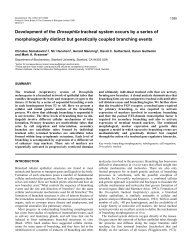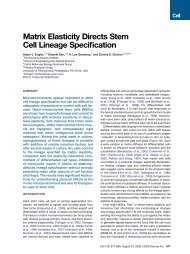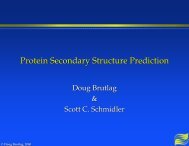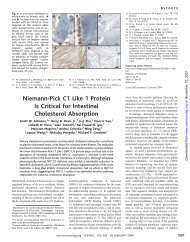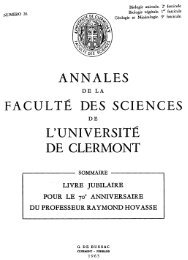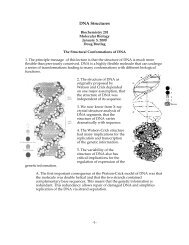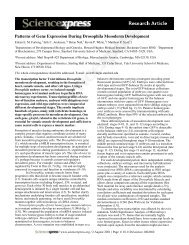DNA Topology Handout - Cmgm Stanford
DNA Topology Handout - Cmgm Stanford
DNA Topology Handout - Cmgm Stanford
Create successful ePaper yourself
Turn your PDF publications into a flip-book with our unique Google optimized e-Paper software.
<strong>DNA</strong> <strong>Topology</strong>in the <strong>DNA</strong> helix than one would expect given the natural pitch of <strong>DNA</strong> in solution(10.4 base pairs per turn).When a linear <strong>DNA</strong> is free in solution it assumes a pitch which contains 10.4base pairs per turn. This is less tightly wound than the 10.0 base pairs per turn in theWatson and Crick B-form <strong>DNA</strong>.In order to understand the origin of supercoiling; imagine a linear <strong>DNA</strong> 5200base pairs in length. If the <strong>DNA</strong> were in the B-form one would expect the two strands ofthe helix to be wrapped around each other 500 times (5200 bp/10.4 bp/turn). Imagine alinear <strong>DNA</strong> in which the two ends become connected to form an open circle. This isreferred to as a relaxed circular <strong>DNA</strong>. On the other hand, if the linear <strong>DNA</strong> wereunwound 10%, say 50 turns, before its ends were joined, then the <strong>DNA</strong> moleculewould be under stress. When the molecule is free in solution it will coil about itself inspace as the two strands simultaneously twist about each other in order to return toequilibrium value of 10.4 base pairs per turn.<strong>DNA</strong> that is underwound is referred to as negatively supercoiled. The heliceswind about each other in a right handed path in space.<strong>DNA</strong> that is overwound also will relax and assume a supercoiled conformationbut this is referred to as a positively supercoiled <strong>DNA</strong> helix. Positively coiled <strong>DNA</strong> hasits <strong>DNA</strong> helices wound around each other in a left-handed path in space.Linking, Twisting and WrithingThe total number of times one strand of the <strong>DNA</strong> helix is linked with the otherin a covalently closed circular molecule is known as the linking number L k .1. The linking number is only defined for covalently closed <strong>DNA</strong> and its value isfixed as long as the molecule remains covalently closed.2. The linking number does not change whether the covalently closed circle isforced to lie in a plane in a stressed conformation or whether it is allowed tosupercoil about itself freely in space.-2-



